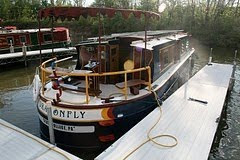Commercially viable hybrid electric boats are on their way, but in the meantime, let's compare Dragonfly with a popular hybrid road vehicle, the Toyota Prius.
| Factor | Dragonfly | Prius |
|---|---|---|
| Model year | 1990 | 2010 |
| Weight (lbs) | 28,000 | 3,000 |
| Seats (driver and passengers) | 8-10 | 5 |
| Sleeps | 7 | 0 |
| Engine (hp) | 63 | 98 |
| Motor (hp) | 12 | 36 |
| Fuel consumption, engine only (mpg) | 5-6 mpg | N.A. |
| Fuel, consumption, engine only (gph) | 1 gph | N.A. |
| Fuel consumption, engine-motor actual use (mpg) | 10 mpg | 50 mpg |
| Fuel consumption, engine-motor actual use (gph) | 0.5 gph | 1.0 gph |
| Fuel storage | 100 gal | 12 gal |
| Range, engine-motor actual use | 1000 miles | 600 miles |
| Bathrooms | 2 | 0 |
As you can see, the canal boat is clearly the better performer in the category, "Number of bathrooms." The rest is a little harder to compare. After all, we're contrasting a floating 2BR/2BA house with a car. (A nice car, for sure.)
Here are a couple of other carefully selected facts:
- Every mile of Prius travel is powered, directly or indirectly, by fossil fuels. The energy for the vehicle's electric motor comes from the vehicle's gas engine. (Even the brake regen energy comes--indirectly--from the motive force of burning gasoline). In contrast, when Dragonfly is running on its electric motor, all of the energy used to move it is solar photovoltaic. (For our Great Loop trip, we had no other way of recharging the propulsion batteries).
- For full-time cruising boaters, a boat is not just their vehicle; it is also their home. For us in 2010-11, Dragonfly was not just a replacement for our Honda Fit; it was also, from an "ecological footprint" perspective, a replacement for our 4-bedroom house (which was rented to someone else, and consequently part of their ecological footprint).






Wow what a Great Information about World Day its very nice informative post. thanks for the post. http://www.isoenergy.co.uk/electric-car-charging-points
ReplyDelete